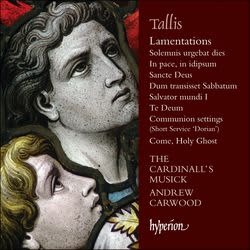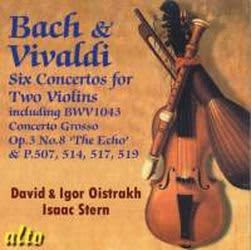Description
Artists
|
When researching English music of the sixteenth century, too often work is hampered by lack of biographical detail, sometimes even by lack of the music itself. There is also scant information about the performance of particular pieces on particular occasions. Unlike the modern age when cathedrals publish and preserve the list of music sung each day, sixteenth-century records rarely, if ever, refer to specific pieces. Typical of this is the account from the Grey Friars in London describing Queen Mary’s triumphant entry into the capital in 1553. The singing of a particular text is mentioned but nothing more: With so little information we cannot be sure why and when pieces were written or performed. So, quite why composers started to set words from the Lamentations of Jeremiah in Latin in the mid-sixteenth century is unclear. Certainly they had to strike out in new directions. They had to move away from the Mass, Magnificat and Antiphon compositions which had dominated the years of Henry VII and the early years of Henry VIII. Edward VI’s Protestant regime had no need for music in Latin but Mary encouraged it as a sign of her re-unification with Rome. Queen Elizabeth I seemed content with music in both Latin and English. There are ten Lamentations settings from composers working in England in the mid-sixteenth century and, although there is a Continental tradition which pre-dates them, these are the first English examples. All of them have an opening section which states from where the words are taken, and all of them use the Hebrew letters which are printed in the Bible at the beginning of each verse. Each setting (except one) also concludes with the phrase ‘Jerusalem, Jerusalem, convertere ad Dominum Deum tuum’ (‘Jerusalem, Jerusalem, turn to the Lord your God’). This is exactly how they are required to be sung during the Holy Week Tenebrae services in the Catholic rite and the obvious conclusion therefore is that they were written for the reign of Queen Mary. However there are difficulties with this assumption. Two settings by Robert White are written in a style which seems to hearken back to the pre-Reformation, including the use of the high treble voice, but there are moments when he seems to use a more modern style. Thomas Tallis and Osbert Parsley both use a lower scoring but both appear to be in a style more in vogue during the reign of Elizabeth in the 1560s rather than under Mary in the 1550s. All three composers use texts in accordance with the liturgical requirements. William Byrd also uses the lower-voice scoring but makes changes to the text; his setting is clearly a product of his early years. Indeed there is some suggestion that he wrote it under the tutelage of Tallis and so it is unlikely to date from before 1560. John Mundy provides the latest setting (published in 1585). He is the most unconventional of all them, using some verses from outside the Book of Lamentations and omitting the final exhortation. There are also four sets by Elizabeth’s Italian spy-composer Alfonso Ferrabosco, all in a Continental style, efficient and consistent in their use of voices and text setting. Tallis’ settings seem stylistically to fit better with his other music for Elizabeth than with his music for Mary as they are like the finest chamber music. He has taken Archbishop Cranmer’s edict about one note for each syllable to heart and this leads to a rhetorical style which communicates the text clearly and with great power (although Tallis allows himself a greater expansiveness in the Hebrew letters). He creates some wonderful effects: pathos at ‘Plorans ploravit’, indignation at ‘virgines eius squalidae’ and ravishing beauty at many of the Hebrew letters. It seems more likely that these composers were writing during the reign of Elizabeth. Perhaps they were simply drawn to the sad nature of the text. Perhaps this was a secret code to communicate Catholic sympathies—it seems likely, certainly in the mid-period works of Byrd, that the deserted city of Jerusalem was a metaphor for England deprived of its Catholic faith. Or perhaps it was composers paying compliments to each other, emulating ideas and developing them further. In any case these settings provide a fascinating topic for discussion about what might have been going on in the mind of the mid-century composers, especially those like Tallis who had been required to alter their compositional style but who had not changed their religious allegiance. We are still unsure as to the exact date of Tallis’ birth—no records have yet come to light—but so complete is his understanding of the pre-Reformation style that he must have been born in time fully to experience and assimilate it, hence placing his birth around 1505. The first official record we have describes him as organist of the very modest Benedictine Priory of Dover in 1532. By 1537 he had come to London and found employment at the church of St Mary-at-Hill in Billingsgate, but in 1538 he moved again, this time to the Augustinian Abbey at Waltham in Essex. This proved to be something of a mistake. Henry’s systematic suppression of the monasteries began in earnest in 1536 (Dover Priory was an even earlier casualty in 1535) and ended in 1540 when Waltham Abbey was the last to be dissolved. Tallis found himself with neither job nor pension but quickly re-surfaced as a singing man in the choir of Canterbury Cathedral. In 1544, Tallis’ name is found on the lay subsidy roll for the sovereign’s private chapel, the Chapel Royal; he is presumed to have returned to London sometime after 1542. Tallis married his wife, Joan, in or around 1552 and in 1557 was granted a twenty-one-year joint lease on a manor in Minster near Thanet in Kent by Queen Mary. In 1572 Tallis and his younger colleague William Byrd (1539/40–1623) petitioned Elizabeth for financial assistance and she responded by granting them a twenty-one-year monopoly on the printing and publishing of music. The Cantiones sacrae of 1575 was their only foray into the commercial world of publishing. Today it is appreciated as a fine collection of motets but at the time it quickly proved a financial disaster and led to a further petition for funds from the Queen in 1577. Tallis’ connection with the Chapel Royal remained throughout his life and he undoubtedly would have filled a variety of roles as composer, teacher, organist and singer. He died around 20 November 1585 and was buried in the Church of St Alphege in Greenwich. Sancte Deus is certainly the earliest piece included here. It belongs to the reign of Henry VIII and bears a striking resemblance to a piece of the same name by Philip van Wilder, one of Henry’s favourite composers. It has an unusual scoring where the voice parts are required to do unusual things—the bass part sounding above the tenor part from time to time and the contratenor being almost as high as the triplex on occasion. Its text, in honour of Christ, suggests a piece of the late 1530s or early 1540s when devotion to Mary was being discouraged. Rather like an older Marian Antiphon it is in several sections but each section (and the whole piece indeed) is much shorter. Tallis makes use of fermata most usually associated with the mention of the name of Christ but not used for that purpose here. It also has a gloriously extended final Amen reminiscent of the tradition of dramatic conclusions to the more expansive Antiphons. The Te Deum ‘for meanes’ is difficult to ascribe to a particular period. It is thought by some to belong to the 1540s and this is perfectly possible, although it is on a grander scale than the ‘Dorian’ Service thought to date from Edward VI’s reign (1547–1553). It is scored for five voices and then has divisions for the two sides of the choir (Decani and Cantoris) to work in dialogue with each other. Its length and occasional use of imitative style may well suggest that it belongs to the early years of Elizabeth’s reign, but as the only surviving sources for this piece are from the seventeenth century it is difficult to be sure. The Communion settings from Tallis’ Short Service (also called his ‘Dorian’ or ‘First’ Service) are a good example of the sort of music that Edward VI expected from his composers. They are rigorously syllabic and homophonic and must have been quite a shock to those used to the expansive and lengthy settings written by Robert Fayrfax, Nicholas Ludford and John Taverner. They are scored for four voices, with the two sides of the choir in dialogue, and display a cool restraint throughout with an austere beauty. The movements are presented in the order required by the 1552 Book of Common Prayer with the Gloria at the end of the service. It is clear that Tallis is writing more for the 1552 model than the 1549 version as he includes the Responses to the Commandments and omits the Benedictus. The brief Offertory sentence Not every one that saith unto me is not officially part of the ‘Dorian’ Service and survives only in the Chirk Castle Partbooks, but it fits well into this sequence: liturgically it is an option in the 1549 Prayer Book but not in the 1552. It is possible that Tallis had to change direction very quickly indeed during this period! Three pieces recorded here fit with Mary’s restored Catholic rite. The Hymn Solemnis urgebat dies (‘Iam Christus astra ascenderat’) for the Feast of Pentecost uses its plainsong melody for the odd verses set against polyphony for the even ones. A gently decorated form of the chant is quoted in full in the soprano part whilst underneath is an undulating set of lower parts which employ homophony often slightly at variance with the top part, something which gives a constant sense of forward momentum. Of the two Responds, In pace, in idipsum is for the late night Office of Compline and Dum transisset Sabbatum is for Easter Day. They follow a different repeating structure: A1 A2 – B – A2 – C – A1 A2 in the case of In pace and A1 A2 A3 – B – A2 A3 – C – A3 for Dum transisset. In pace quotes the chant only occasionally in the polyphony whereas Dum transisset uses it in the top part throughout. Three pieces definitely belong to the reign of Elizabeth. Two are found alongside Archbishop Parker’s metrical translation of the Psalms into English and published by John Day in 1567. Why brag’st in malice high is a setting of Psalm 52 whilst Come, Holy Ghost (or Tallis’ ‘Ordinal’ as it is commonly called) is a beautiful setting of the Veni Creator used during ordination ceremonies and at Whitsun. The third, a setting of Salvator mundi, was published in the 1575 Cantiones sacrae, the joint venture with William Byrd and the attempt to make a significant statement on the health and quality of music in England. It is placed first in the collection, as befits Tallis’ senior position and the exquisite nature of the piece. It begins in imitative fashion, with the superius and contratenor in canon at the octave, but quickly moves into a style which is more free and more expressive. |









